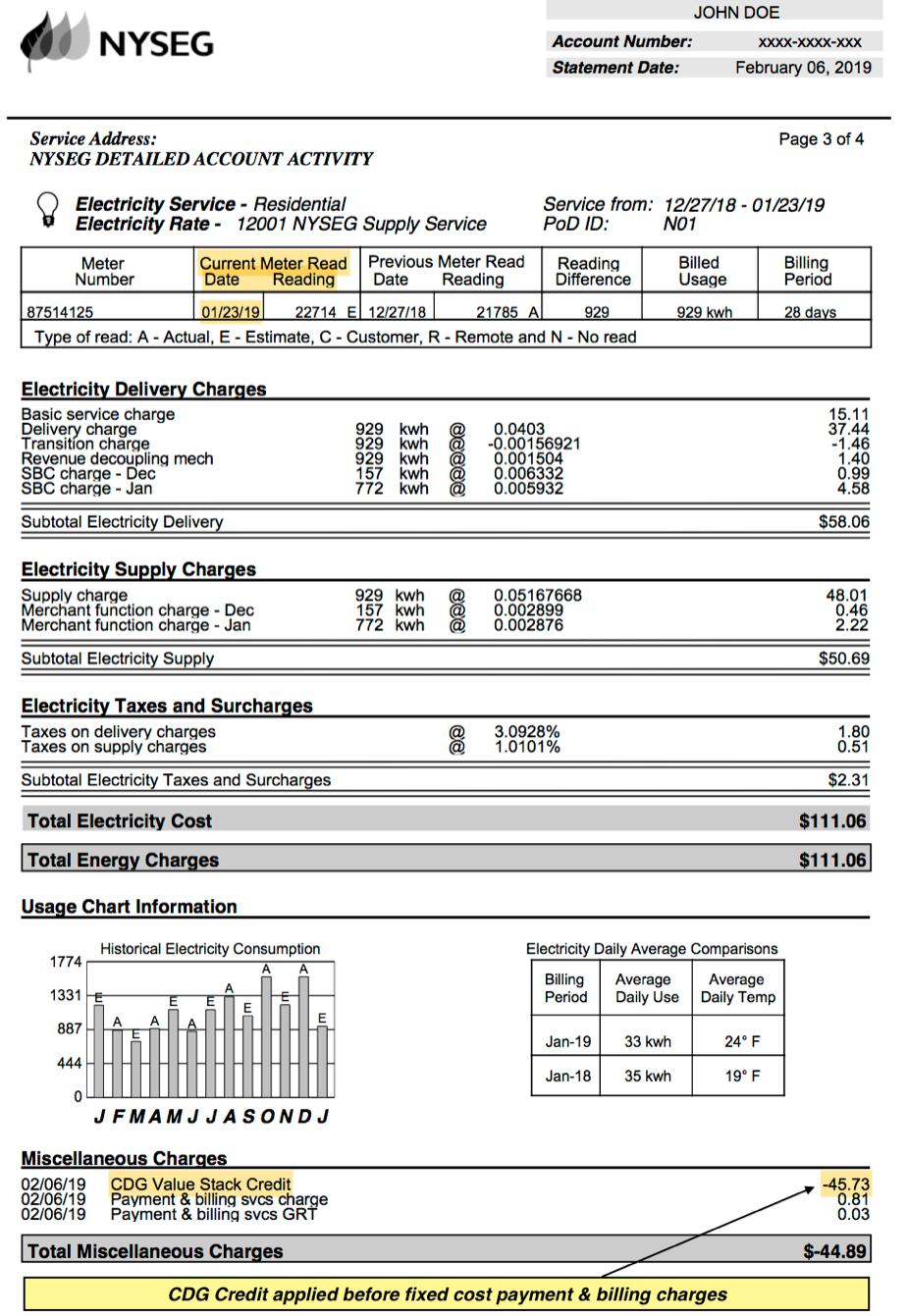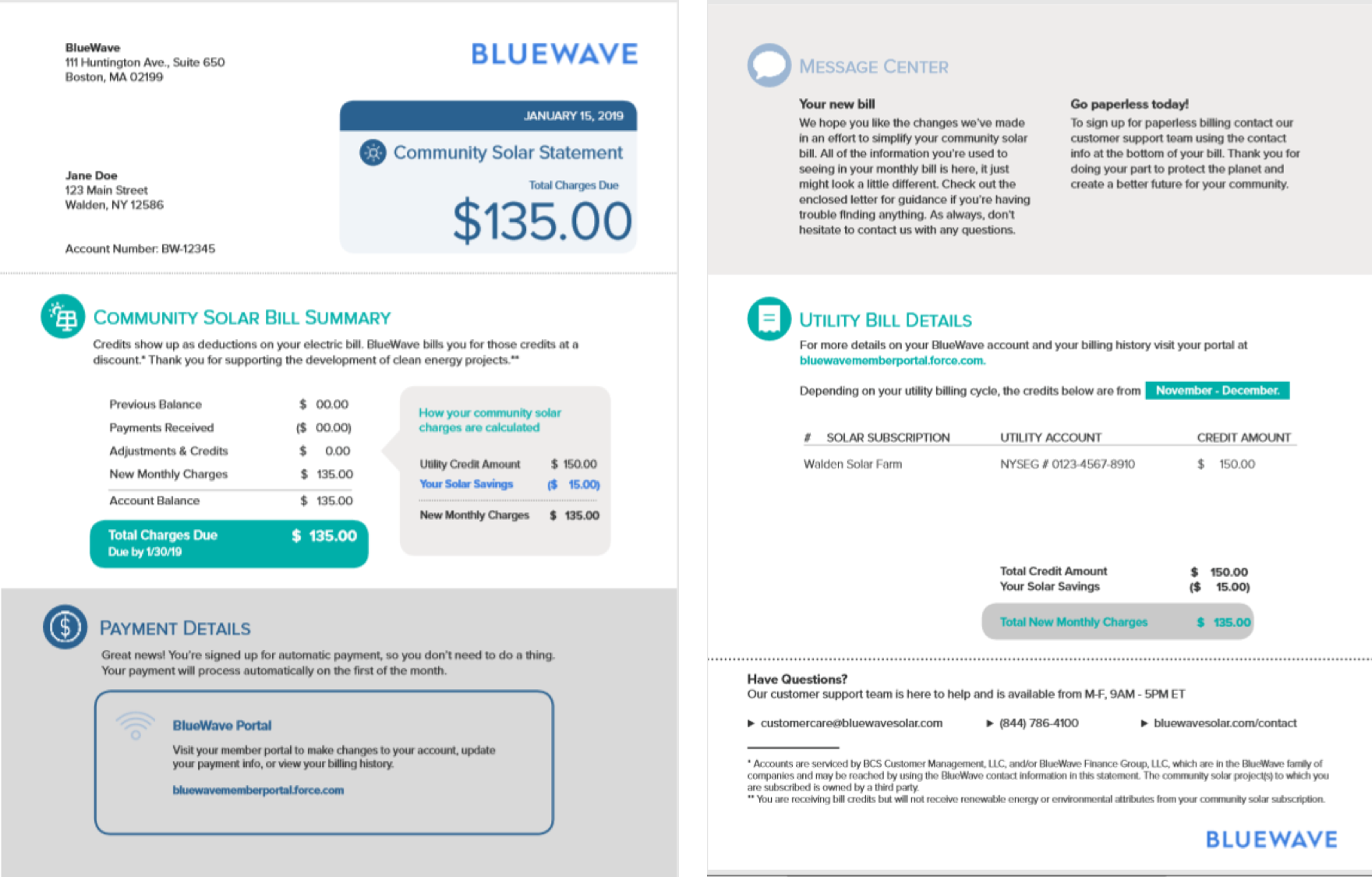
A 2016 GreenTech Media article reveals how many of us feel about electricity bills: “consumers spend about 6 minutes annually thinking about their electricity bill.” But who can blame us? For the most part, 6 minutes per year—a.k.a. 30 seconds per month—are enough to keep our lights working, phones charged, and TVs running.
But things are changing. While electricity bills remain in the backlogs of our minds, many of us have begun to think more seriously about the ecological impact of our energy usage. With the recent rise in solar development and other renewable energy sources, supporting clean energy no longer necessarily requires a financial investment or a change in lifestyle. Many of these clean power opportunities even allow you to save money in addition to the environment.
Community solar is a great example of one such opportunity: it allows households and small businesses to support clean energy and access savings without any financial investment. The catch? In truth, there is no catch—with BlueWave it’s free to sign up and you save money on your annual electric bills while supporting clean energy generation. However, signing up for community solar does call for us to think about utility bills a little differently—and perhaps for a few more minutes each year.
But we don’t want a confusing bill to get in between you and the savings that community solar can provide! Nor do we want to let some confusing wording to prevent you from protecting our planet. So, we’re going to break down how community solar billing works so you can access all the benefits community solar has to offer. We promise this will be the most valuable 6 minutes you ever spend thinking about utility bills.
Ready to educate yourself on how to save?
When you sign up for a community solar subscription, you are signing up to support a local solar farm. (Click here if you want a quick community solar refresher). As your subscribed farm generates electricity, your utility measures the amount of electricity produced and assigns that electricity a dollar value in the form of a “solar credit.” The value of a solar credit is determined by multiple factors including the type of solar project and the value of energy at the time that energy is produced. With your subscription, a share of these credits is applied to your monthly electricity bill, reducing what you owe your utility.
In a given month, the number of credits you receive is determined by the size of your subscription share and the total amount of electricity generated by the array. Although this number can vary from month to month, it is possible that your credits will offset your entire electricity bill, bringing the amount you owe your utility to zero. However, this does not mean that you are getting free electricity—you will still be billed for the credits by BlueWave.
Where are the savings then?
Your savings come from a fixed percentage discount that we apply to your solar credits. Say your discount rate is 10%. If your subscription generates $100 of solar credits in a given month, we charge you $90, and you pocket the $10. Multiply that times every month and you’re starting to make some serious savings. Discount rates vary from state to state, but on average, you can expect to save between 5% and 10% on your electricity costs throughout the year.
While this billing mechanism brings you savings, it also means you’ll receive two bills every month—one from your utility, and one from BlueWave. Here’s a rundown of the two bills using an example utility we service in New York:
The first bill: your utility bill

Example Utility Bill - NYSEG
Your utility bill will look the same, and you’ll receive the same electricity from the grid as before. The one difference is that you will see a new negative line item for your solar credits. On the NYSEG bill above, your community solar credits will be labeled as “CDG Value Stack Credits.” Other utilities have different naming conventions for this line item: “Net Metering Credit” (Eversource), “Transfer of Remote Net Meter Credit” (National Grid). This line is located on the third page of the bill in the Miscellaneous section. For an in-depth description of how to read a bill like this NYSEG bill, check out our blog post. The main thing to note is that the negative line item represents the dollar value of the solar energy produced on your farm.
The BlueWave bill: your new, savings-generating bill:

The BlueWave Bill: Front and Back shown left to right
At the top of your BlueWave bill, you will see a statement of how much you owe for your solar credits for the month. This amount is calculated by taking the total amount of credits your subscription generates and applying a fixed percentage discount. In the section below the statement, “Community Solar Bill Summary,” you can see how it all breaks down. On the second page, the Utility Bill Details section will tell you which month the credits you are being billed for were generated, which farm you are subscribed to, and how much you are being charged for the current monthly period. It will also show you your credit amount and your solar savings for the month.
Common Customer Questions
Today, BlueWave provides Customer Care for over 2,500 subscriptions. Collectively, these subscriptions represent almost $3M in customer savings. They have also led to some common questions from our customers on how this all works. We’ve compiled answers to the top questions from our customers below.
Where do my savings come from?
Your savings come from a discount that BlueWave applies to your BlueWave bills. BlueWave is able to provide this discount based on state established and utility supported community solar incentives. These incentives are designed to let households and businesses participate in the clean energy revolution without needing to make an upfront investment or install their own household panels. Signing up for community solar savings is a great way to make sure you are taking advantage of incentives that are available in your utility territory.
Why doesn’t my community solar subscription cover my whole utility bill?
We base your subscription size—how many credits you are able to generate per month—on your average annual electricity usage. Month to month, these credits may cover slightly more than your bill, or slightly less. When you receive more credits than you need to offset your utility bill, your credits will be saved and applied to your next bill. Additionally, if you change your energy consumption habits to reduce your household usage, you can adjust your subscription share so that your credit allocation better suits your new consumption level. Credit balances on your utility account will be saved and applied to your next bill.
In the case that you receive fewer credits than you need to offset your entire utility bill, your utility bill will still be reduced—just not down to zero. As a result, there may be months in which you owe both BlueWave and your utility. This usually happens because of varying levels of sunlight season to season, which can affect the solar energy generated on your solar farm from month to month. But no matter the variation, you’ll always see savings over the course of a year.
Why is my BlueWave bill higher in the summer than the winter?
Because sunlight levels vary from month to month, especially in the Northeast, solar panels will produce different amounts of electricity depending on the season. You’ll likely see a surplus of credits in the summer and fewer credits in the winter. In the case of a surplus, your BlueWave bill will be higher since you are charged for the credits you generate in a given month. Don’t worry, though, this does not mean you are losing money. Even though you may generate and pay for more credits than you use in a given month, your utility saves up those credits for you and applies them during the darker colder months when you might not generate enough credits to offset your electricity bill. You can think of it as “pre-paying” for your fall electric bills during the summer and know that you’ll have savings over the course of the year.
Why don’t the dates of my utility and BlueWave bills match up?
You may notice that your utility bill and BlueWave bills are charging you for different dates. That’s because there is a one to two-month lag between when your credits are transferred to your utility account and when BlueWave bills you for those credits. This delay means that the credits you pay for on your BlueWave bill may not be an exact match with your utility bill that month. We do this so you’ll always see the credit bring down your utility bill before BlueWave charges you for that credit at a discount.
What if I want to cancel my subscription?
We get it, people move! You can cancel your subscription at any time or transfer your subscription to your new home if you’re staying local or even pass it on to a neighbor. Most of our customers do not have cancellation fees associated with their accounts. If you are not sure if you do, please reach out to our Customer Care Team. Depending on your billing cycle, there may be a few months’ delay before credits finish transferring to your utility account.
What happens to my community solar share rate if utility rates change?
If electricity rates increase or decrease, your fixed percentage discount on your credits will remain the same—even if the dollar value of that savings fluctuates. You'll be saving money on your credits no matter what happens to electricity prices.
More questions?
Please reach out to our team with any and all questions at customercare@bluewavesolar.com
Want to join the revolution?
Click the link to see what you can save by signing up.


